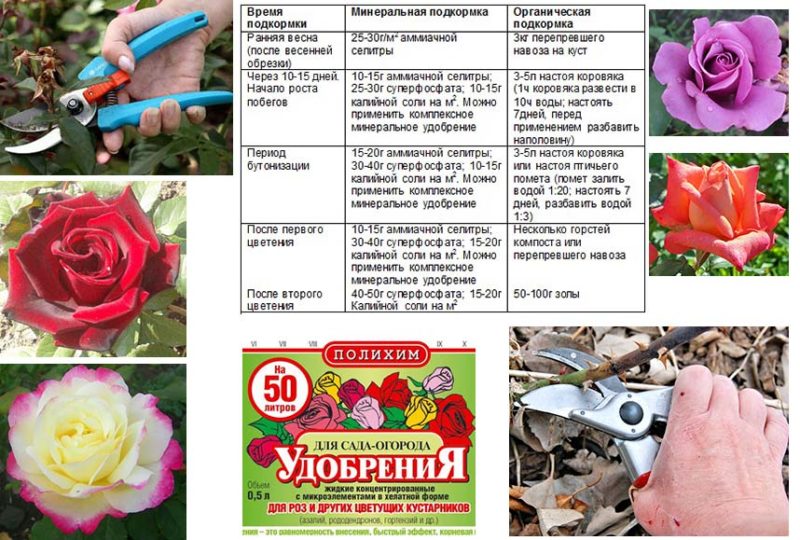How and what to feed roses in July for lush flowering
The queen of garden flowers - a lush and fragrant rose - needs in careful care and regular feeding. Nutrient mixtures should include micro- and macroelements: nitrogen, phosphorus, potassium, calcium, magnesium, manganese, sulfur. We will tell you in this article how to feed roses in July and what fertilizers are needed for abundant flowering.
Do roses need fertilizing in July?
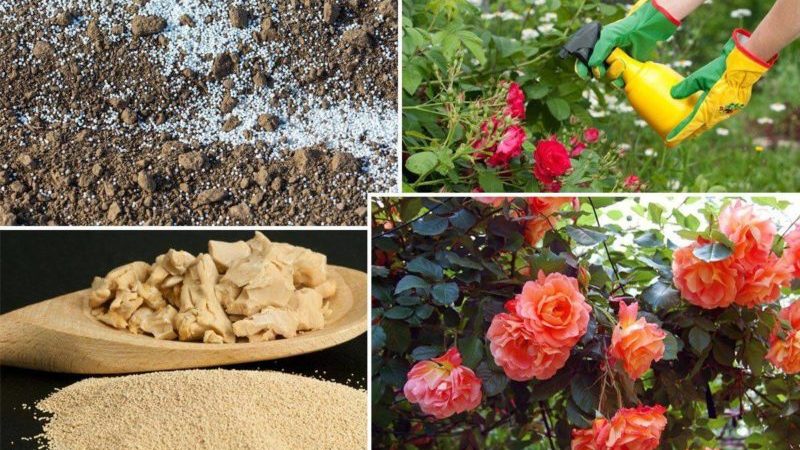
All varieties of garden roses need feeding throughout the season, but not more than 2 times a month. In summer, buds are laid, and the rose especially needs potassium and magnesium. For lush flowering, fertilizing is applied both by root and foliar methods.
On poor soils in early - mid-July, flowers are fed with mineral compounds. Particularly dangerous is nitrogen, which provokes the growth of green mass. Instead of a blooming rose garden, there is a risk of getting a spreading bush with lush foliage and no buds. Nitrogen stimulates the development of new shoots and inhibits the ripening of wood, resulting in a decrease in the winter hardiness of the flower.
Important! From July 15-20 it is recommended to exclude nitrogen. Its excess leads to the development of powdery mildew and slow lignification of shoots.
What feeding does a rose need in July?
Summer fertilizers for roses should include micro- and macroelements. Without them, the flower loses its ability to develop and bloom normally. Nutritional deficiency leads to deformation, drying out, loss of color of leaves, shredding of buds, and their partial or complete absence.
List of basic elements for roses:
- Nitrogen is responsible for the health and brightness of the color of shoots and foliage.
- Phosphorus is necessary for the plant to form buds.
- Potassium helps the plant absorb phosphorus.
- Calcium is responsible for the development of the root system.
- Magnesium promotes chlorophyll synthesis.
- Manganese, iron, zinc, copper improve the plant's metabolism and increase the flowering period.
Symptoms and consequences of deficiency and excess of substances are presented in the table.
| Nutrient element | Shortage | Excess |
| Nitrogen | Pale leaf color, red dots, premature leaf fall. Shortened shoots, weak flowering, incomplete ripening of wood. | Dark green foliage, rapid growth of green mass, soft stems, development of fungal diseases. |
| Phosphorus | Dark green leaf color with a purple or red tint, brown-violet stripes on the edges and spots on the back of the leaf blade. Purple petioles and stems, weak shoots. Delayed flowering. | Soil salinization, metabolic disorders, inability to absorb iron and copper. |
| Potassium | Yellow leaves with green veins, dry edges. Changing the yellow tint to red-violet. Small buds, young leaves are red with brown edges. Blackening and death of lower leaves. | Retarded growth and development of the bush. |
| Calcium | Weak stems, dry tops of young leaves, dying flower stalks. | Delayed root development. |
| Iron | Yellow edges of the leaf blade, a narrow green stripe along the vein on a completely yellow leaf, discolored small veins. Gradually the leaves become white-cream. | Pale leaves and shoots. |
| Magnesium | Colorless spots on the leaves, dark red areas between the veins, red-yellow dead zones, while the edges of the leaf blade remain green. | Delayed absorption of potassium. |
| Sulfur | Light green leaves, red spots. | An excess is usually not observed. |
Deadlines
Roses are fertilized strictly after flowering, 2-3 times a month. Some gardeners prefer to work according to the phases of the moon.
In 2020, the most favorable dates for fertilizing are:
- dry and liquid fertilizers: July 2-3, 6-7, 11-19, 29-30;
- exclusively dry fertilizers: July 9-10, 16-17, 25-26.
Favorable days in 2021:
- dry and liquid fertilizers: 4-7, 13-17, 19-22, 27-28, 31 July;
- exclusively dry fertilizers: 1-3, 11, 18, 24-25, 29-30.
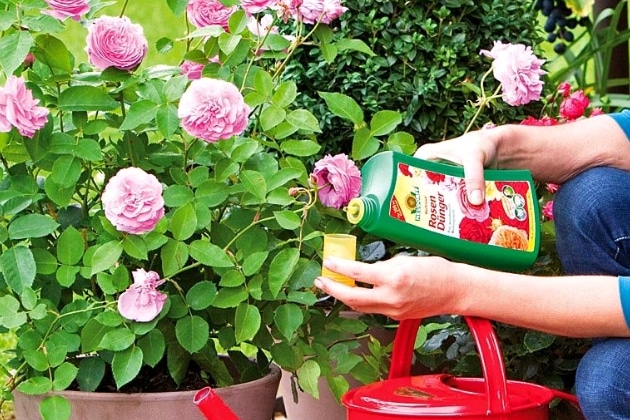
What to feed
Mineral fertilizers are produced in the form of powder, granules, tablets, and solutions. Organics are added in liquid form and combined with minerals. The combination of both types allows you to achieve maximum results.
Mineral fertilizers
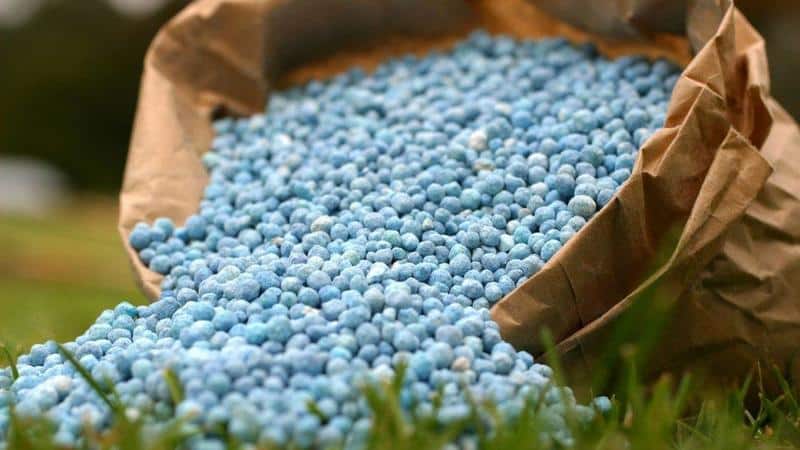
There are special fertilizers on sale with nitrogen, phosphorus and potassium in optimal dosages. The products of the following companies have proven themselves to be excellent: Gardena, Pokon, Agricola-Aqua, BioEkor, Gloria (magnesium granules), Gera (potassium humate and microelements), Spezial-Rozendunger.
After flowering, roses are fertilized with a universal complex with potassium and phosphorus (“Kemira universal”) together with an infusion of mullein or bird droppings.
Nitrogen is especially effective and useful for growing green mass in early July. To prepare a solution, take 1 tbsp per 10 liters of water. l. urea or ammonium nitrate. Fertilizing is applied once in early July.
Potassium and phosphorus are added as a complex once during the budding period. The most popular fertilizer for all flowering plants:
- superphosphate (30 g per 10 l of water);
- potassium sulfate, potassium magnesium (30 g per 10 l of water).
In case of calcium deficiency, the bushes are fed with calcium nitrate (25-30 g per 10 liters of water).The drug "Kemira Universal 2" will help replenish calcium deficiency (30 g per 10 liters of water).
Mineral fertilizer "Gloria" in granules has a prolonged effect and contains magnesium and calcium. Fertilizer is evenly scattered over the soil before digging.
Bona Forte fertilizer in liquid form is poured into plastic cans. It contains magnesium, succinic acid, and microelements in chelated form. Flowers are fertilized from early spring to mid-July once with a break of 10-15 days.
This is interesting:
How to care for a home rose in a pot - a guide for beginner gardeners
A guide to cutting roses in the fall at home for beginning gardeners
How to protect bushes and how to treat roses in spring from diseases and pests
Organic compounds
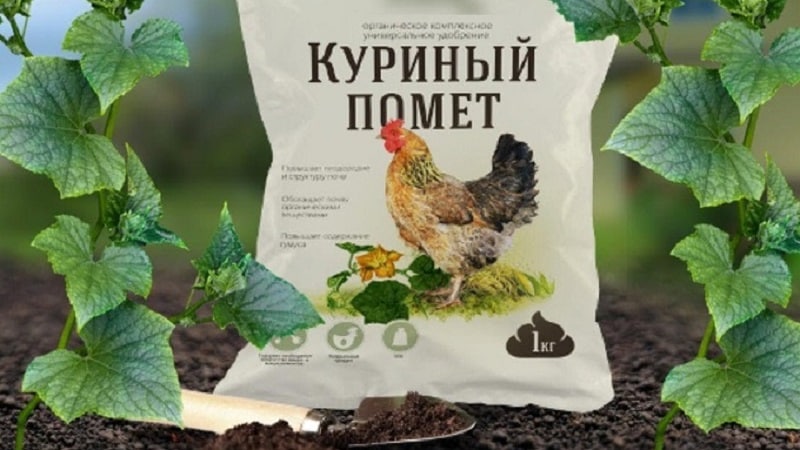
Organic fertilizers are prepared independently. These are the same folk remedies, the components for which the gardener always has on hand: compost, manure, peat, green manure.
Advice. Do not use fresh manure to feed roses; it burns the plant’s root system. Use rotted manure instead.
Organic fertilizer recipes:
- 2.5-3 liters of chicken manure per 50 liters of water. The mixture is infused under the lid for 4-6 days, then diluted with water 1:10. Before use, add 30 g of superphosphate and 500 g of ash to the solution. For irrigation, dilute 3 liters of infusion in 10 liters of water.
- 5 liters of manure, 500 g of superphosphate, 500 g of ash per 50 liters of water. The mixture is infused for a week. For irrigation, 5 liters are diluted in 10 liters of water.
- The barrel is filled 80% with fresh mullein and filled to the brim with water. For every 10 liters add 100 g of ash. The mixture is infused for 14 days, stirring occasionally. Before use, 30 g of superphosphate, potassium sulfate or potassium magnesia are mixed into the infusion.
- For 10 liters of water, take 100 g of wood ash for irrigation and 200 g per 10 liters for spraying foliage. During use, the solution is constantly stirred to obtain a suspension.
- Fresh nettles along with roots are tightly placed in a 10-liter bucket, 100 g of superphosphate and 200 g of ash are added, filled with water and left for a week. To speed up the process, leave the bucket in the sun. For irrigation, use unstrained infusion (1 l / 10 l); for spraying, it is filtered and diluted before use (0.5 l / 10 l).
Slurry is applied to the soil, and mineral compounds are applied to the foliage, reducing the dosage by 3 times.
How to fertilize for lush flowering in the garden
In July, rose buds form, so during this period the plant needs potassium-magnesium supplements. For abundant and long-lasting flowering, gardeners use:
- superphosphate (30 g per 10 l);
- sodium humate in the composition of ready-made complex fertilizers (“Gera”);
- ammonium nitrate (30 g per 10 l);
- potassium magnesia (30 g per 10 l).
Many gardeners use folk recipes: a solution of horse manure or mullein mixed with wood ash, nettle infusion.
Before and during budding, the bushes are fed with a mixture of potassium sulfate and superphosphate in a ratio of 30:100 per 10 liters of water. After watering, a solution of mullein and a herbal infusion based on nettle is added to the soil. Then the soil is carefully mulched with rotted cow manure. Mulch should not come into contact with branches and leaves.
Choosing feeding in the middle zone
When growing roses in the climate of central Russia, foliar feeding is particularly effective. Nutrients applied to foliage quickly penetrate plant tissues even with a lack of sunlight and low soil temperatures.
The composition is applied using a spray bottle in the evening or in cloudy weather. Fertilizing is not applied at the slightest sign of fungal diseases and during the flowering period.
In the Urals
During the budding period, rose bushes are fertilized with complex mineral compounds based on phosphorus and potassium (potassium monophosphate, double superphosphate). To stimulate flowering and increase the diameter of flowers, special preparations (“Bud”) or products based on gibberellic acid are used.
Spraying is carried out after the appearance of young shoots in early July. To prepare the solution, take 2 g of stimulant per 1 liter of warm water.
In Siberia
In Siberia, fertilizing is applied from June to July. At the end of May - mid-July, rose bushes are fed:
- mullein solution 1:15 or chicken manure 1:20, when the shoots reach 10 cm in height;
- complex mineral fertilizers during the first budding period.
In August, fertilizers are not applied, since additional feeding provokes a re-growth of green mass and negatively affects winter hardiness.
How to feed roses
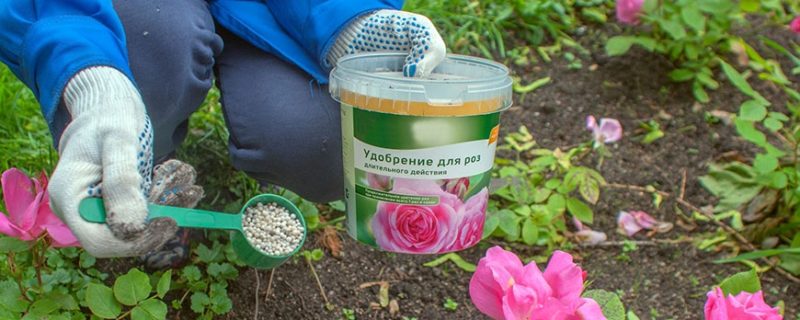
Fertilizers for garden roses are applied in two ways: root and foliar. Each of them has its own characteristics. To determine which method is best for roses, gardeners recommend trying both and evaluating the result. It all depends on the growing conditions, soil type and climate characteristics.
Root fertilizers are applied immediately after watering or rain, so as not to burn the roots. For foliar procedures, herbal infusions are often used. Rose bushes are sprayed in the evening or in cloudy weather so that the nutritional composition does not evaporate under the influence of sunlight.
The root way
Root fertilizers applied directly to the soil using a dry or wet method are considered the most effective. A shallow trench with a radius of 15 cm is dug around the stem. Fertilizer mixed with turf is placed in it and covered with soil. When watering, fertilizers dissolve and penetrate deeply into the soil, gradually saturating it with nutrients.
Foliar
Foliar feeding is applied when the plant is weakened or weather conditions are not the most favorable. The composition is applied with a spray until the foliage is completely wetted. Processing is performed on both sides.
Foliar fertilizers should include micro- and macroelements. Nitrogen and potassium dissolve well in cold water, so it is convenient to prepare solutions immediately before spraying. Superphosphate is infused in water at room temperature for 24 hours. It is recommended to apply foliar fertilizing in dry but not hot weather.
Nutrient solution recipes:
- 30 g of urea per 10 liters of water (to prevent fungal diseases and insect attacks);
- Leave 10 g of sodium humate in 3 liters of hot water for 10 hours, then prepare a working solution with the addition of water (250 ml of concentrate per 5 liters of water);
- 50 g of superphosphate per 1 liter of hot water, leave for 3-4 hours, strain, dilute in 10 liters of water, add 20 g of potassium nitrate before processing the bushes;
- 10 g of magnesium sulfate per 10 liters of water;
- 25 g of calcium nitrate per 10 liters of water.
Foliar fertilizers are applied immediately after mixing. They do not salinize the soil and do not destroy beneficial microorganisms and earthworms. Foliar feeding should not be done on wet foliage, in cold, rainy weather or on a day when heavy dew is expected. Of particular danger is foliar feeding on leaves with pockets of black spot.
Advice from experienced gardeners
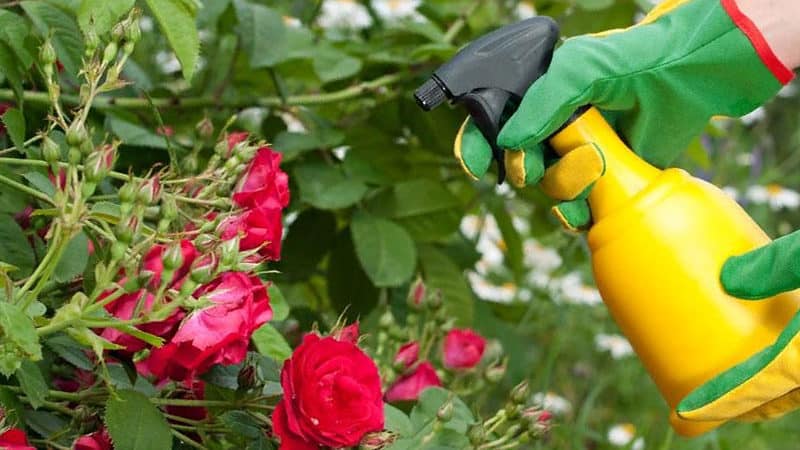
Advice from experienced gardeners will help maintain the beauty and health of your garden rose garden in the summer:
- Before feeding roses during flowering and budding, please note that fertilizing can only be done at the stage of active bud formation. The procedure is not carried out during the flowering period. Add organic matter and minerals after flowering.
- Soak superphosphate in hot water; the granules do not dissolve well in cold water.
- Roses respond gratefully to nitrogen fertilizing, but try to stay in moderation and completely eliminate this microelement from mid-June.
- A solution based on pressed yeast is an excellent top dressing, which always helps out in the absence of a ready-made solution with microelements. Dissolve 1 kg of fresh yeast in 10 liters of warm water, and dilute 1:10 with water before use. Pour 1 liter under each bush.
- Leave the rotted manure for digging until the fall, and in July, pour a solution prepared from 1 kg of bird droppings and 10 liters of water under each bush once.
- Use wood ash when growing roses in acidic soils. The solution prolongs the flowering period and saturates roses with additional microelements.
- For better absorption of nutrients, alternate between organics and minerals.
Conclusion
For lush and abundant flowering, roses need organic and mineral fertilizers. When using them, it is important to remember that root and foliar fertilizers are applied either during budding or after flowering.
Nitrogen fertilizing is applied until mid-July, then completely stopped. Excess nitrogen provokes a set of green mass, stops lignification, thereby worsening the winter hardiness of the plant.Minerals such as potassium, magnesium, and phosphorus are responsible for the bright color of leaves and flowers. Manganese, iron, zinc, copper increase the flowering period.
